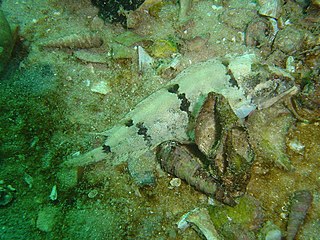
Galaxias olidus, the mountain galaxias, is a species of freshwater galaxiid fish widely found in southeastern Australia.

The Tasmanian mudfish, Neochanna cleaveri, is a small Australian amphidromous fish in the galaxiid family, of the order Osmeriformes.

The whitefin dogfish is a species of deep-sea dogfish shark in the family Etmopteridae. It has only been found in the northwest Pacific Ocean off the southeastern coast of Japan, between the latitudes of 35 and 32°N. It inhabits continental slopes and seamounts at a depth of 320 to 1,100 m. Reproduction is ovoviviparous. It is of no interest to fisheries and almost nothing is known of its biology. The specific epithet ritteri is in honor of Dr. William Emerson Ritter of the University of California.

The longnose sawtail catshark is a little-known species of catshark, part of the family Scyliorhinidae, found off the northwestern Pacific islands of Amami Ōshima, Ogasawara, and Izu at depths of 350–550 m (1,150–1,800 ft). Reaching a length of 80 cm (31 in), it is characterized by a long flattened snout, a long space between the pelvic and anal fins, and a crest of enlarged dermal denticles along the dorsal caudal fin edge. Adults are plain dark gray above, while juveniles have a few faint dark saddles on the back and tail.
Denticetopsis is a genus of catfishes of the family Cetopsidae.

The longnose shiner is a species of ray-finned fish in the genus Notropis.

Clinus agilis, the agile klipfish, is a species of clinid found in subtropical waters of the Atlantic Ocean from Namibia to South Africa where it is commonly found in estuaries and tide pools. This species can reach a maximum length of 10 centimetres (3.9 in).
Astyanax microschemos is a species of characid fish from Brazil. It belongs to the A. scabripinnis species complex and differs from other species outside it by having a lower number of branched anal fin rays and its shallow body depth being about 26.9-29.7 vs more than 35% of its standard length (SL). Compared to species of its own complex, it can be distinguished by the combination of its shallow body depth, and smaller interorbital width. The species name comes from the Greek mikroschemos, meaning "low stature", which refers to the shallow body depth of the animal.

Deuterodon pelecus is a species of characid fish from Brazil. It can be distinguished from other species by: its body depth ; its short and pointed snout smaller than the orbital diameter; and a reduced number of branched anal fin rays. D. pelecus also differs from members of its genus by its characteristic color pattern. It possesses a single humeral spot that is constricted to the region above the lateral line; at the same time it shows a conspicuous midlateral body stripe from opercle to the caudal fin base, an autapomorphy of this precise species. Other Deuterodon species have a humeral spot that is vertically or horizontally elongate and have the midlateral stripe becoming faint near that humeral spot. The species name is derived from the Greek pelekus, meaning "axe", referring to the pigmentation shape resulting from the adjoinment of the humeral spot with the midlateral stripe.
Galaxias arcanus, the riffle galaxias, is a galaxiid of the genus Galaxias, a member of the Mountain Galaxias species complex group of freshwater fish, found in Australia.
Galaxias brevissimus, the short-tail galaxias, is a galaxiid of the genus Galaxias, a member of the Mountain Galaxias species complex group of freshwater fish, found in Australia.
Galaxias gunaikurnai, the Shaw galaxias, is a galaxiid of the genus Galaxias, a member of the Mountain galaxias species complex group of freshwater fish, found in Australia.
Galaxias lanceolatus, the tapered galaxias, is a galaxiid of the genus Galaxias, a member of the Mountain Galaxias species complex group of freshwater fish, found in Australia.
Galaxias longifundus, the West Gippsland galaxias, is a galaxiid of the genus Galaxias, a member of the Mountain Galaxias species complex group of freshwater fish, found in Australia.
Galaxias mcdowalli, McDowall's galaxias, is a galaxiid of the genus Galaxias, a member of the Mountain Galaxias species complex group of freshwater fish, found in Australia.
Galaxias mungadhan, the Dargo galaxias, is a galaxiid of the genus Galaxias, a member of the Mountain Galaxias species complex group of freshwater fish, found in Victoria, Australia.
Galaxias ornatus, the ornate galaxias, is a galaxiid of the genus Galaxias, a member of the Mountain Galaxias species complex group of freshwater fish, found in Australia.

Galaxias supremus, commonly known as the Kosciuszko galaxias, is a galaxiid of the genus Galaxias, a member of the Mountain galaxias species complex group of freshwater fish, found in Australia.
Galaxias tantangara, commonly known as the stocky galaxias, is a galaxiid of the genus Galaxias, a member of the Mountain galaxias species complex group of freshwater fish, found in Australia. Only discovered in 2014, the fish is classed as critically endangered, mainly because of being preyed upon by introduced species of trout.
Galaxias terenasus, the roundsnout galaxias, is a galaxiid of the genus Galaxias, a member of the Mountain Galaxias species complex group of freshwater fish, found in Australia.









